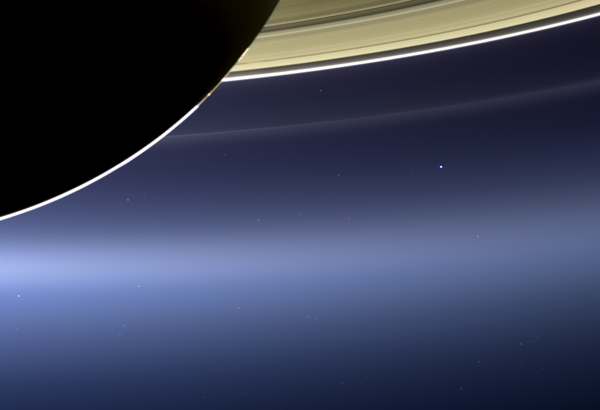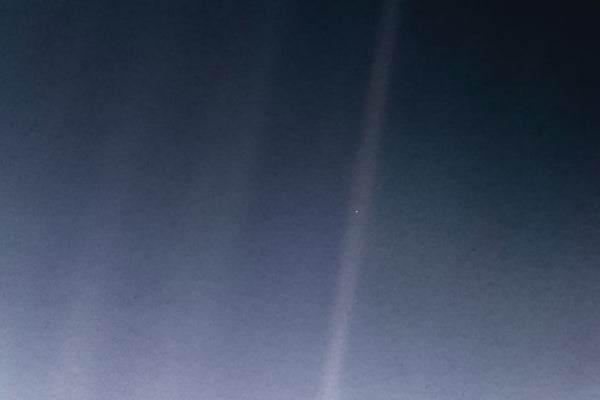This article was published in Scientific American’s former blog network and reflects the views of the author, not necessarily those of Scientific American
Thirty years ago, on February 14, 1990, the Voyager 1 spacecraft directed its cameras to take one last historic array of planetary images. Sitting high above the ecliptic plane, nine years and three months beyond its last planetary encounter with Saturn and four billion miles from the sun, farther than the orbit of Neptune, the spacecraft intercepted and executed a set of instructions to acquire 60 individual exposures of seven of the eight planets, the sun and the vast nothingness in between. This simple sequence of commands and these last images of the of tens of thousands taken by Voyager 1 and its sister craft, Voyager 2, in their journeys across the solar system, capped a groundbreaking era in the coming of age of our species.
A daring, endless trek to the outer planets and beyond, the Voyager mission became iconic over the years in its scope and meaning: more rite of passage than expedition, more mythic than scientific. The extraordinary images of alien worlds never before seen, and the precognitive sense of being there that they evoked, connected laypeople the world over to Voyager’s historic pilgrimage into the unknown, with eternity the final port of call. It was not folly to feel that the mission would gift us all a measure of immortality.
The fabled Golden Record of Voyager heightened the fascination. The two Voyagers each carried a phonograph record of images, music, and sounds representative of our planet, including spoken greetings in 55 languages to any intelligent life-form that might find them. This was a message from Planet Earth vectored into the Milky Way—a hopeful call across space and time to our fellow galactic citizens. It thrilled to think that news of us and our home planet might be retrieved by some extraterrestrial civilization, somewhere and sometime, in the long future of our galaxy.
On supporting science journalism
If you're enjoying this article, consider supporting our award-winning journalism by subscribing. By purchasing a subscription you are helping to ensure the future of impactful stories about the discoveries and ideas shaping our world today.
Because of its never-ending journey, its dazzling scientific discoveries in the solar system, and its human-forward countenance, to participants and onlookers alike, Voyager became symbolic of our acute longing to understand our cosmic place and the significance of our own existence. It left no question of our status as an interplanetary species. It is, even today, the most revered and beloved interplanetary mission of them all, the Apollo 11 of robotic exploration.
Perhaps the most poignant gesture of the Voyager mission was its final parting salute to its place of birth. The portrait of the sun’s family of planets taken in early 1990 included an image of Earth. Carl Sagan, a member of the Voyager imaging team and the captain of the small team that had produced the Golden Record, had proposed this image to the Voyager project in 1981. He eventually called it, appropriately, the Pale Blue Dot. His motivation is expressed in his book of the same name, in which he describes wishing to continue in the tradition begun by the famous Earthrise images of the Apollo program, referring specifically to the one taken from the surface of the moon by Apollo 17. Then, he continues:
It seemed to me that another picture of the Earth, this one taken from a hundred thousand times farther away, might help in the continuing process of revealing to ourselves our true circumstance and condition. It had been well understood by the scientists and philosophers of classical antiquity that the Earth was a mere point in a vast encompassing Cosmos, but no one had ever seen it as such. Here was our first chance.
Though Carl had convinced a small group of Voyager project personnel, and imaging team leader Brad Smith, to provide the required technical, planning, and political support, the project leaders were not willing to spend the resources to do it. Carl’s 1981 proposal was rejected, as were his other proposals over the following seven years.
Completely unaware that Carl had initiated such an effort, I was independently promoting the very same idea—to take an image of the Earth and the other planets—soon after I became an official imaging team member in late 1983. I had in mind the sentimental “goodbye” that would lie at the heart of any image taken of our home planet before Voyager headed out for interstellar space, and the perspective it would give us of ourselves—our small and ever-shrinking place in Voyager’s ever-widening view of our cosmic neighborhood. Also, the “cool factor” in presenting a view of our solar system as alien visitors might see it upon arrival here was another draw.
For two years, I hawked the idea around the project and, not surprisingly, like Carl, got nowhere. But Voyager's project scientist, Ed Stone, did his best to encourage me by advising that if there was some science to be obtained by an image of Earth, it might then be possible. As I couldn’t think of any, I gave up and began instead thinking of other scientific observations of the inner solar system that could be made from the outer solar system. The result: In 1987 we used Voyager 1 to attempt to image the asteroidal dust bands discovered by the Infrared Astronomical Satellite in 1983. Regrettably, nothing was detected.
It wasn’t until 1988 that I finally became aware of Carl’s proposal. After telling him that I had had the same idea a few years earlier—and, like him, tried and failed to get it jump-started—he requested my help, suggesting that I compute the exposure times. (A letter I wrote to Carl after our conversation, in 1988, summarizing that conversation and reporting on my calculations, is archived in the Library of Congress.)
It is an ironic historical footnote to this story that the most difficult calculation of the bunch was the exposure for the Earth. As no spacecraft had ever taken an image of Earth when it was smaller than a pixel, and since the cloudiness of its atmosphere is so variable that its inherent brightness is hard to calculate or predict, there was no information available then to suggest confidently how long an exposure should be. Somehow, it all worked out.
The Pale Blue Dot image of Earth is not a stunning image. But that didn’t matter in the end, because it was the way that Carl romanced it, turning it into an allegory on the human condition, that has ever since made the phrase “Pale Blue Dot” and the image itself synonymous with an inspirational call to planetary brotherhood and protection of Earth.
Considering my history with the concept, it was only natural that only several months after the Pale Blue Dot image was taken, when I learned I would be the leader of the Imaging Team for the Cassini mission to Saturn, I put at the top of my bucket list to do the Pale Blue Dot all over again, only to make it better and make it beautiful. And it occurred to me in the planning of the Cassini redo, how great it would be if we let the people of the world know in advance that their picture would be taken, from a billion miles away—and invite them at the appropriate time to go out, contemplate the isolation of our home in space, appreciate the rarity it is among the sun’s planets, marvel at all of life on Earth, and smile at simply being alive on a pale blue dot.
And we did all that—on July 19, 2013.

“The Day the Earth Smiled” image, with our planet visible below Saturn’s rings. Credit: NASA, JPL-Caltech, Space Science Institute and CICLOPS (Cassini Imaging Central Laboratory for Operations).
I called it “The Day the Earth Smiled.” It became a gorgeous image of Saturn and its rings in the foreground and our blue ocean planet, a billion miles in the distance, adrift in a sea of stars.
The significance of images like this—our home seen at significant remove as a mere point of blue light—lies in the uncorrupted, unpoliticized view they offer us of ourselves, a view of all of us together on one tiny dot of a planet, alone in the blackness of space. Our scientific explorations, and images like this, have shown us that thereis literally no place else for us to go, to survive and flourish,without extraordinary, and I would submit, unrealizable effort.
Science fiction aside, it may really be that humanity’s last stand is right here on Earth, right where it all began, and the lesson going forward now is: We had better make the best of it.
Carl was right. As he wrote in 1994:
[The Pale Blue Dot] underscores our responsibility ... to preserve and cherish the pale blue dot, the only home we’ve ever known.
In August 2012, in another historic first, Voyager 1 escaped the magnetic bubble of the sun, becoming the first human-made object to enter interstellar space. That glorious historic undertaking, that redefined us every step of the way, had done it again. At that point, our species became interstellar. Thanks to Voyager, we are now card-carrying citizens of the Milky Way.
